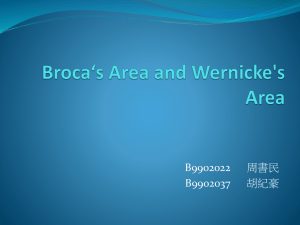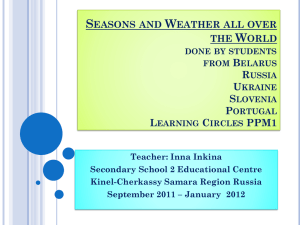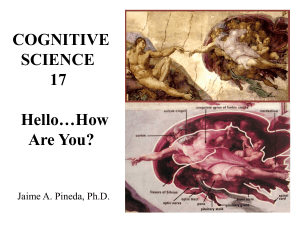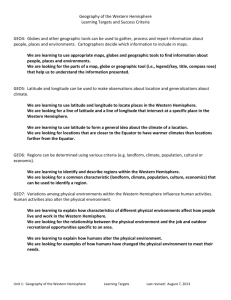NrLangB0cPrj - PROFESSOR AC BROWN
advertisement
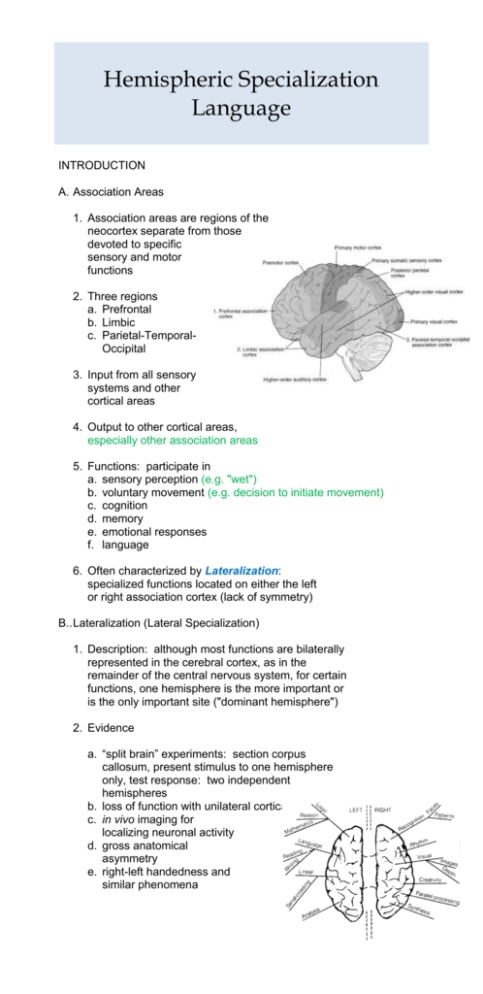
Hemispheric Specialization Language INTRODUCTION A. Association Areas 1. Association areas are regions of the neocortex separate from those devoted to specific sensory and motor functions 2. Three regions a. Prefrontal b. Limbic c. Parietal-TemporalOccipital 3. Input from all sensory systems and other cortical areas 4. Output to other cortical areas, especially other association areas 5. Functions: participate in a. sensory perception (e.g. "wet") b. voluntary movement (e.g. decision to initiate movement) c. cognition d. memory e. emotional responses f. language 6. Often characterized by Lateralization: specialized functions located on either the left or right association cortex (lack of symmetry) B.. Lateralization (Lateral Specialization) 1. Description: although most functions are bilaterally represented in the cerebral cortex, as in the remainder of the central nervous system, for certain functions, one hemisphere is the more important or is the only important site ("dominant hemisphere") 2. Evidence a. “split brain” experiments: section corpus callosum, present stimulus to one hemisphere only, test response: two independent hemispheres b. loss of function with unilateral cortical lesions c. in vivo imaging for localizing neuronal activity d. gross anatomical asymmetry e. right-left handedness and similar phenomena C. Left and Right Association Cortex Note: Not all individuals show the same pattern or degree of hemispheric specialization. The following description applies to the large majority of the population. 1. Left hemisphere specialization (dominant or categorical hemisphere) a. understanding and manipulating language: recognition, use, and understanding of words and symbols b. speech c. writing d. identification of objects by name e. mathematics, logic, analysis 2. Right hemisphere specialization (nondominant or representational hemisphere) a. spatial-temporal relationships b. identification of objects by shape or form (e.g. stereognosis, face recognition) c. attention based on form recognition d. recognition of emotion e. recognition of tunes, rhythms f. synthesis, holistic problem solving 3. Relation to handedness 4. Assumption of function after injury to a. handed individuals (90% of population) 1) left hemisphere dominant: 2) right hemisphere dominant: right96% 4% b. left-handed individuals (10% of population) 1) left hemisphere dominant: 70% 2) right hemisphere dominant: 15% 3) neither hemisphere dominant; 15% 4. Assumption of function after injury to dominant hemisphere a. in early childhood, the opposite hemisphere can assume much of the function of the injured hemisphere b. in adults, injury to a hemisphere leads to moreor-less permanent disability c. even in adults, the opposite hemisphere is able to assume some function after injury D. Cognition 1. Define: The ability to attend to external stimuli or internal motivation, to determine the significance of such stimuli, and to plan appropriate responses (analysis of input, memory, strategy of action) 2. Evaluation: Cognitive screening tests; e.g. Mini-Mental State Exam (MMSE) INTRODUCTION (continued) E. Pathology 1. Apraxia (G., lack of action): condition of being unable to perform a skilled movement despite intact neuromuscular function and desire to do the movement 2. Agnosia (G., lack of knowledge): unable to recognize an object via a specific sensory modality even though basic sensation using that modality is normal 3. Aphasia (G., lack of speech): impairment of any language ability; may include difficulty in producing or comprehending spoken or written language 4. Neglect: condition of being unable to direct attention 5. Dementia: loss of cognitive ability (more loss than typical of aging) in a previously normal person CORTICAL REPRESENTATION OF SPEECH AND LANGUAGE A. Speech Representation 1. Broca’s area a. location: frontal lobe, adjacent to area of primary motor cortex controlling muscles of vocalization b. output: primary motor cortex vocalization muscles c. input: Wernicke’s area d. role: in dominant hemisphere, processes information into detailed pattern necessary for vocalization e. pathophysiology: motor aphasia 2. Wernicke’s area a. b. c. d. e. location: posterior region of the superior temporal gyrus input: visual, auditory, and somatosensory interpretive areas output: Broca's area role: language, thought, “intelligence” pathophysiology: inability to recognize or form coherent thought; sensory aphasia LANGUAGE PATHOPHYSIOLOGY A. Aphasias 1. Wernicke's aphasia (Receptive aphasia, Fluent aphasia) a. Lesion - usually left posterior part of temporal lobe, although extends to ventral part of parietal lobe b. Visual and auditory language input can be impaired, but speech is fluent c. Patients use the wrong word or combination of words, add additional syllables to words or words to phrases, or tend to make up words d. Speech contains little meaning because of the abundance of words; e.g., when asked where he lived, the patient said "I came here before here and returned there" (i.e., called empty speech) e. Patients are usually unaware of their errors 2. Broca's aphasia (Expressive aphasia, Nonfluent aphasia) a. Lesion: area 44 and 45 on the dominant (usually, left) side b. Characterized from complete muteness to slowed, deliberate speech constructed from simple grammatical structures (e.g., the phrase "the large gray cat" may become "cat") c. Comprehension of spoken and written language is seldom disturbed (but expression by writing often exhibits the same problems as when speaking) d. Patients are generally aware of their errors e. Patients can sometimes express themselves by singing 3. Conduction aphasia a. Lesion of the pathway (arcuate fasciculus) between Wernicke's area and Broca's area b. Characterized by incorrect words, inability to repeat, deficits in naming 4. Speaking in sign language a. Deaf people can become aphasic for sign language following lesions in the left hemisphere. The deficits can involve deficits in expression with good comprehension (Broca’s), or signing fluently but with many mistakes while having difficulty comprehending the signing of others (Wernicke’s). In all cases, the ability to move the hands is not impaired. b. Thus, signing and language use similar structures of the left hemisphere B. Other Language Disorders 1. Disorders of reading and writing a. Pure word blindness - unable to read but can understand when words are spelled and is able to spell words correctly (Alexia) b. Cannot comprehend written words but can copy them (If unable to write words, termed agraphia) c. Typically involve damage to the part of the corpus callosum which connects the visual associational cortex 2. Dyslexia as a developmental disorder of reading “Dyslexia is an inability to read effortlessly or with complete understanding, even though the cognitive and intellectual capacities of the children are usually normal or even superior.” a. Impairment of the phonemic (phoneme = unit of language expression) processing b. Problems with a sequence of characters c. Tendency to read from right to left (particularly difficult for some words such as "was" and "saw" d. Difficulty distinguishing between letters that have the same configuration but different orientation (e.g., p and q, b and d, m and w) e. Disproportionate percentage of left-handers are dyslexic f. Postulated anatomical basis: an abnormality in the migration of neurons to the left cortex during development.



